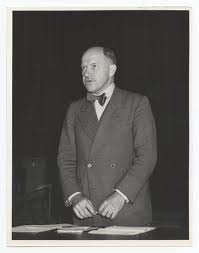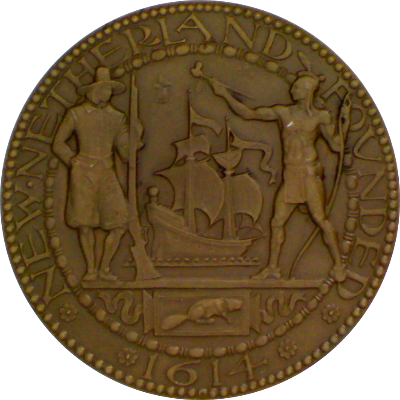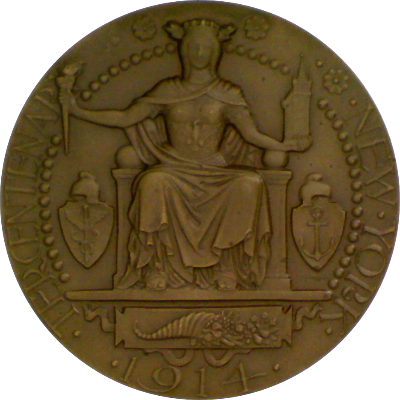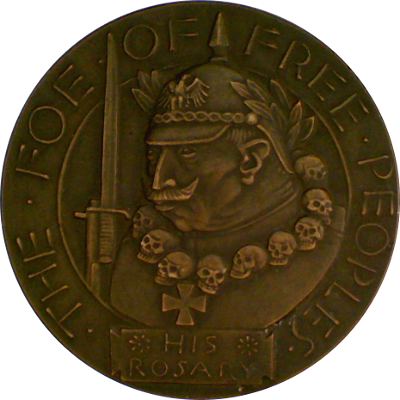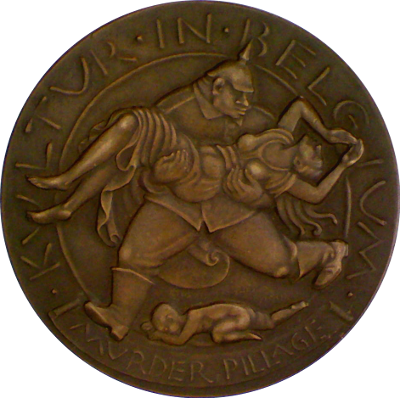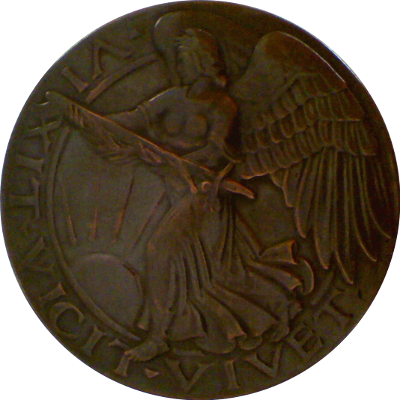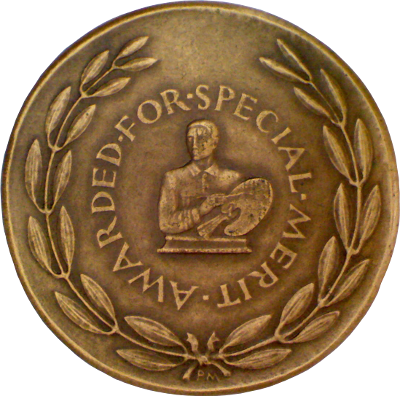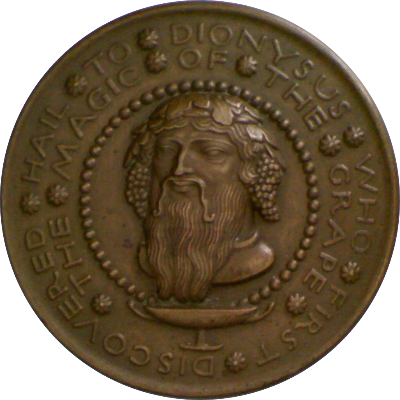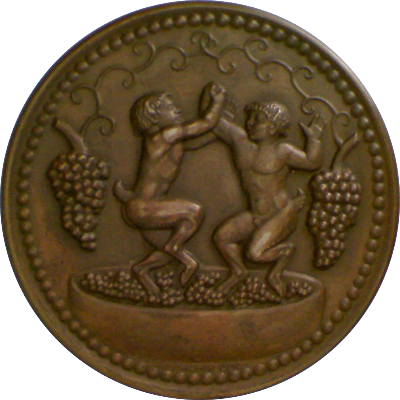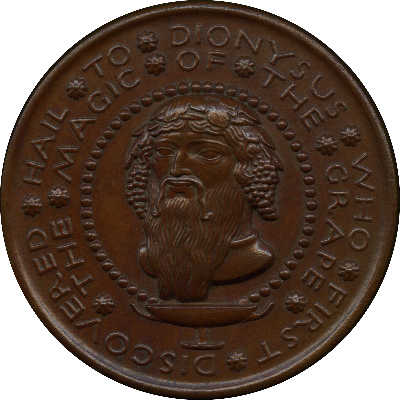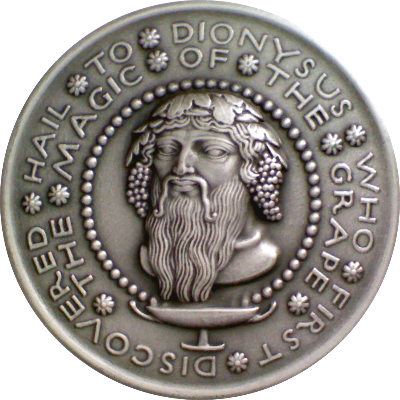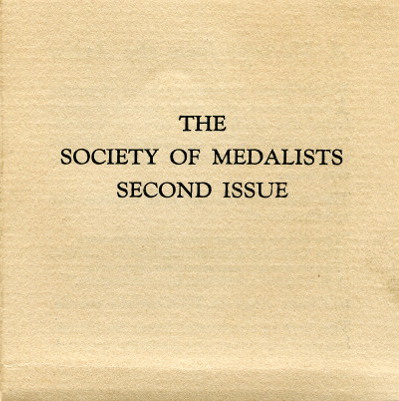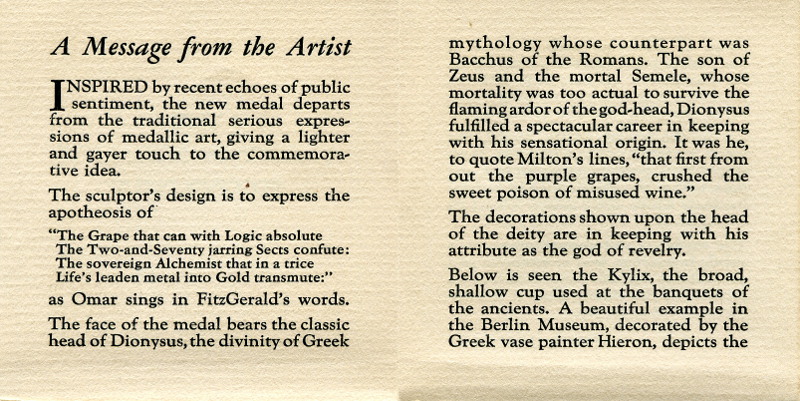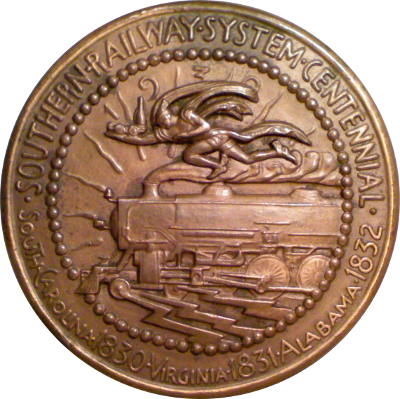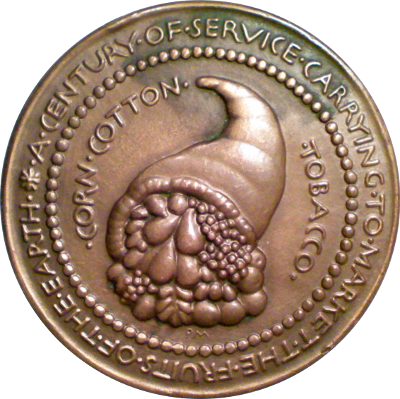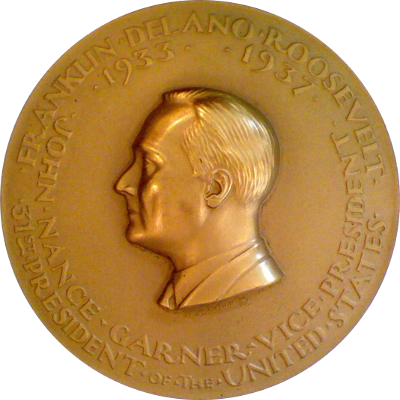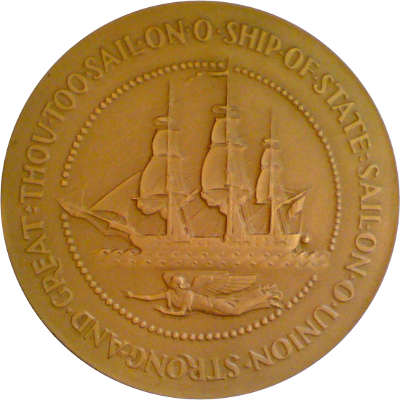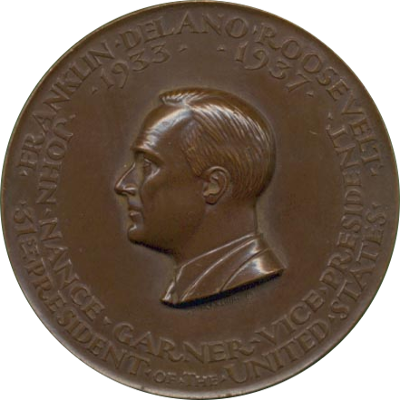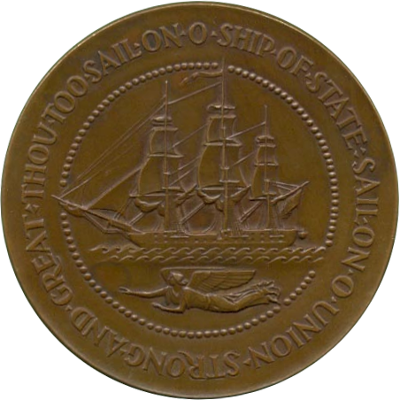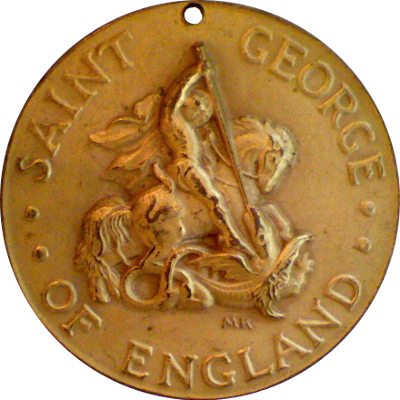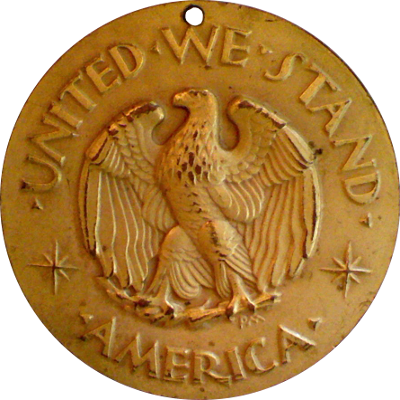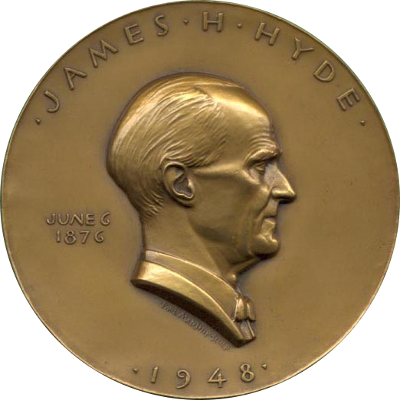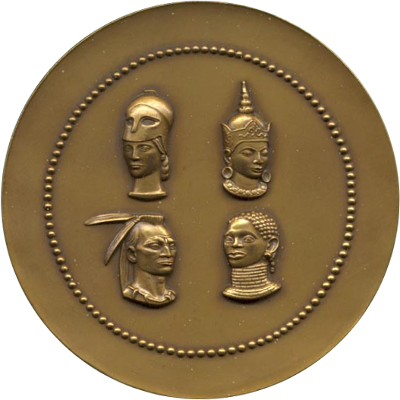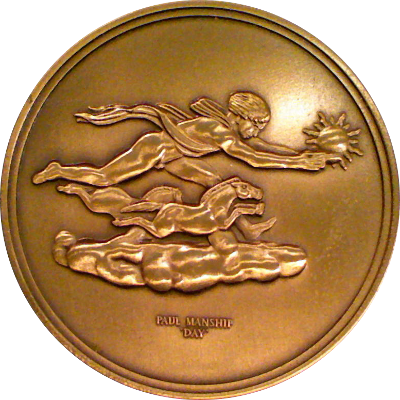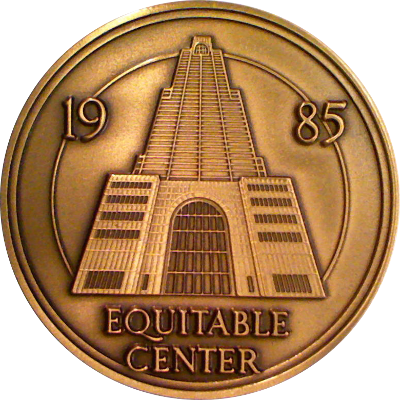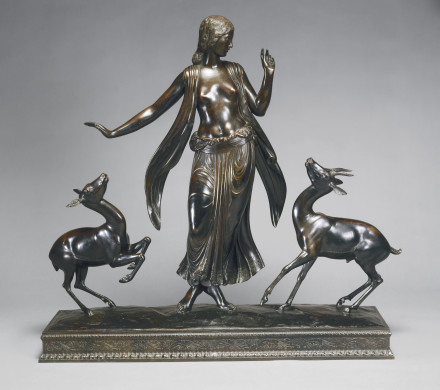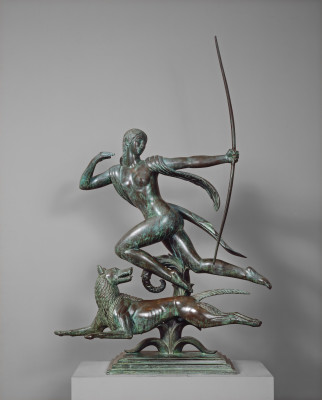Born on Christmas in St. Paul, Minnesota, to Mary Etta Friend (1844-1907) and Charles H. Manship (1843-1911), Paul Howard Manship considered it a good omen that he was the seventh child of a seventh daughter. He began to draw in emulation of his sister Adeline (1874-1893), but it was particularly his brother Luther (1879-1931) who served as an example. Luther earned his living as an engraver though his main interest was painting. Manship began his formal study of art at the Mechanic Arts High School and the Saint Paul School of Art (later the Saint Paul Institute of Arts and Sciences) in Minnesota. His initial decision to pursue a career as a sculptor was largely motivated by his color blindness; he had started out life as a painter. For a painter color blindness is obviously a severe handicap, but for a sculptor it might prove an advantage: the eye, not being distracted by color, could concentrate on form. Indeed, a great sensitivity to form, to contour, and to line was to prove one of Manship's major strengths.
By the age of nineteen, Paul Manship had saved enough from his work as a freelance illustrator and designer to head for New York City where he immediately enrolled at the Art Students League. His sculpture teacher there was Hermon Atkins MacNeil (1866-1947), the first of several sculptors trained at the Ecole des Beaux-Arts with whom Manship was to study. Soon after his arrival in New York, Manship also found a position as an assistant to Solon Borglum (1868-1922), who was working on two major equestrian monument commissions at the time. During his apprenticeship with Borglum, Manship worked almost exclusively on animal figures, developing proficiency with this subject that would serve him well on later commissions. Manship always credited Borglum as the master who had most influenced him. It was also through the Borglum family that Manship met his future wife, Isabel McIlwaine (1883-1874), a student of William Merritt Chase (1849-1916) and a teacher of art at the Hannah Moore School in Baltimore, Maryland.
With money he had saved from working with Borglum, Manship signed up for classes under Charles Grafly (1862-1929) at the prestigious Pennsylvania Academy of the Fine Arts in Philadelphia from 1907-08. When he later moved back to New York, Manship found a job as studio assistant to the Viennese sculptor Isidore Konti (1862-1930). While working in Konti's studio, Manship modeled a decorative relief entitled Man with Wild Horses. He was to show this piece at the National Academy of Design in 1908. This important early plaster had been considered lost until recent years when it was rediscovered and finally cast in bronze. This relief reflects Paul Manship's early mastery of the American academic tradition, before he traveled to Rome and developed his more modern, streamlined style of sculpture.
In 1909, at the age of twenty-three, Manship became the youngest sculptor as yet awarded the American Prix de Rome. By the first decade of the twentieth century, the Prix de Rome had become the most competitive and coveted prize among young American artists. The minimal requirements of this three-year fellowship afforded recipients opportunities to travel through Italy and Greece to study original works on site and in person. The conferral of this honor should be acknowledged as the one event that most closely directed Manship's career. As a result of his studies abroad, Manship developed an affinity for archaic and pre-classical works, and ultimately, the unified linear style of sculpture for which he is well known. His novel approach represented an abrupt break from the popular Beaux-Arts sculptural style of his teachers MacNeil, Borglum, and Grafly.
When Paul returned to New York in the fall of 1912, there was much for him to do. His years in Rome permitted him the leisure to study, work, and to mature in a rich cultural environment, and one where all his economic needs had been met. It was during this time that he evolved into an artist, producing work that was distinctively his own. But now that he was back in New York, earning a living had become a high priority. He had to find a studio and a place to live, and he had to make arrangements for his wedding. He took a studio at 27 Lexington Avenue, at the corner of Twenty- third Street then married Isabel at Grace Church on January 1, 1913, where Paul's funeral was to be held in 1966. In February Manship had a solo exhibition of his new work at the Architectural League in New York. This body of work was an instant success with both critics and the public, resulting in many private and public commissions. This success was followed by two more exhibitions in November, and by the end of the year Paul became father to Pauline Frances Manship. Thus, Manship's professional career and personal life moved briskly forward that year. His growing public appeal can be measured by the response to a show at the Berlin Photographic Company in which almost one hundred pieces were sold. His peers honored his achievement as well with a gold medal at the San Francisco Panama-Pacific Exposition in 1915.
The Manships were a prosperous young couple, socially on the rise in 1915, and their new home and studio at Washington Mews in Manhattan were ideal for entertaining. Manship was a hard worker, but he also played hard. He joined a number of clubs: the National Arts Club; the Players Club; the Coffee House; and his favorite, the Century Club. During the next three summers the family was unable to travel in Europe due to the war so they rented a house in Cornish, New Hampshire, where they participated in the art colony that Saint-Gaudens had helped establish there. Manship also came to know some of the intellectual and artistic elite of Boston, such as Denman Ross of the Boston Museum of Fine Arts, as a result of an exhibition at the Saint Botolph Club. Ross invited Manship to a luncheon with John Singer Sargent, who was eager to meet the sculptor of work that had impressed him on a visit to the Metropolitan Museum of Art in New York City. For Manship, this was an event of considerable importance.
Sargent was then perhaps the most celebrated painter in the world and his great reputation was equaled by a great generosity. Sargent and Manship soon developed a close rapport, despite the thirty-year difference in their ages, and over the years Sargent proved a good friend to the sculptor. Paul Manship was always fortunate in his friends. He made friends easily, and as a friend he was easy-going, undemanding, and profoundly loyal. During these early years of professional success he made a number of friendships that were to be of great importance to him, in some cases for the duration of his life. As a tribute to his deceased friend, the Manships later named their third child and only son John Paul (born 1927) for John Singer Sargent and for his father.
When his reputation in America was secure, Manship moved his family to London, England, where he worked in Sargent's studio during the summer of 1921. He then moved his family to Paris, where his second daughter Elizabeth Robinson was born. (As a grown woman, Elizabeth Manship Solomon distinguished herself as a fine painter, as well.) While Manship refreshed his imagination in the Mediterranean, exhibitions of his work continued in the United States. During this period, Grace Rainer Rogers asked Manship to create a memorial to her brother to be erected at the New York Zoological Park in the Bronx. Paul Rainey had been a big game hunter and animal collector who had trapped rare animals for the zoo until his death in 1925. Manship's innovative format - a set of monumental bronze gates that included a menagerie of animal figures - allowed him to fully explore and exploit the patterns created by the animal form. He also took great advantage of the decorative effect created by the negative spaces of the design.The animals he modeled for this project are wonderfully alive and rather humorous in their depictions of the distinct personalities of each species. Manship returned to many of these same animal figures in later years to fashion new compositions. His habit was to keep working at a theme until he got it right. Indian Hunter and his Dog, for instance, is the culmination of a long series of Indians, hunters, or Davids - partially nude young men with dogs at their sides, which were done over a period of more than ten years. The small version of The Indian Hunter with His Dog has always been one of his most popular pieces.
The Manships were blessed by the birth of their last child, Sarah Janet, in 1929 and were lucky to be well off during the long drought of the 1930s. Ironically, it was the stock market crash of 1929 that indirectly led to the creation of Manship's most celebrated sculpture, because the Depression gave birth to Rockefeller Center. Art was intended to play an important part in the complex and the theme chosen for the center was "New Frontiers and the March of Civilization." Times were bad, and the construction of such an ambitious project was a sign of faith in a prosperous future; art was to underline this message. Manship was never completely happy with the subject of Prometheus, which he was commissioned to represent and which ultimately became his signature work. From the beginning Prometheus attracted an enormous amount of attention and it was considered one of the best-known works of public art in this country next to the Statue of Liberty. Despite Paul's disappointment with this piece, it is characteristic of his art: the gravity-defying figure with its stylized details, the strongly rhythmic outline of the composition, even the ring of the zodiac are all essential elements of Manship's mature work.
Manship also was given one of the choicest sites on the main mall at New York's 1939 world's fair. Paul decided to create a monumental sundial with four sculptural groups signifying the times of day, set in a large reflecting pool. Time and the Fates Sundial and the four Moods of Time were in many ways Manship's favorite works. They summed up his obsession with time. He believed that a major purpose of art, especially of art in the classical tradition, was to reconcile the passage of time with permanence. The monumental groups, which were executed in staff (a plaster of Paris compound) for the world's fair, have been lost; but the working models of various sizes were done in bronze after the war, and they are among Manship's most ingenious, complex, and inventive works.
During the summer of 1943 Manship began looking at property to buy on Cape Ann. It was a good time to do so. The local granite quarries had closed, and the Rockport Granite Company was in bankruptcy; its only business was the liquidation of its real estate. Paul therefore had a wide choice and eventually purchased fourteen acres of quarry land in Lanesville, Massachusetts, across the street from the Natti's farmhouse and a short walk to the village, a distinct advantage during the war, when no one had a car. The property contained two handsome quarries filled with water, delightful for swimming in the summer and for skating in the winter. Because it was wartime, there was difficulty in acquiring building materials. When an old house in Pigeon Cove was offered for sale on the condition it be moved, Manship bought it and had it taken apart and rebuilt. The family moved into this house in the spring of 1945. It was then that Manship was able to buy a splendid oxen barn dating from the 1840s to use as a studio. Work on the Lanesville property continued through the 1950s. Manship made it a showcase for his sculpture, designing a terrace for his world's fair groups.
At the top of his profession, Manship was optimistic about his own role in the postwar world. Honors were bestowed on him from all over the world: corresponding membership in the Academia Nacional de las Bellas Artes in Argentina in 1944 and in the Academie des Beaux-Arts in Paris in 1946, and membership in the oldest of the academies - l'Accademia di San Luca in Rome -in 1952. In the spring of 1945 he was awarded the gold medal for sculpture by the National Institute of Arts and Letters and given a retrospective exhibition in its handsome galleries. Manship was elected the president of the American Academy of Arts and Letters in 1948, and in 1950 he was elected president of the Century Club. When it was possible to travel again after the war, Manship established a routine that he would follow for the rest of his life. At some time during the year he would make a trip to Europe, going to Florence to work at the Bearzi Foundry, to Rome to stop at the Academy, and often to Paris to visit old friends, especially architect Welles Bosworth. During the warm seasons he would travel back and forth to Lanesville, but unfortunately his asthma made it impossible for him to stay there long. After two or three weeks he would have to hurry back to New York to recover in its impure but pollenless air. The rest of the time he spent working in his New York studio. He rarely used his great studio in Lanesville, except for small pieces.
Surprisingly, Manship did very little religious sculpture during his long career. A St. Joseph marble statue, commissioned by C. Grant LaFarge (1862-1938, the son of the great painter John Lafarge) for a church in Providence, Rhode Island, was the only work of consequence he was to do in this genre. It's unclear why this should have been. He was not himself a church-going man, but this shouldn't have made a difference. He certainly was very sensitive to the great tradition of religious art. Perhaps he didn't get church commissions because he didn't seek them out and because he became known for a different type of sculpture. Ecclesiastical art is something of a specialty, and the sculptors of his generation who worked extensively in the field tended to do little else. It is too bad in a way, as he very much enjoyed the challenge of working in many genres.
Paul Manship did commissioned work during his later years, but he also worked on a number of pieces for his own pleasure, including a series of small bronzes modeled originally in wax and cast by the lost-wax process. He had begun doing these works, which he called his "pet creations," in the 1930s, modeling figures in wax the way someone else might knit or do crossword puzzles. He carried a cigar box of wax and toothpicks to use as armatures, especially on his frequent transatlantic flights. He experimented with all types of subjects, often using a semiprecious stone as a base, and the work was done with the freedom and assurance that result from half a century of experience. These pieces are like lyric poems and are probably Manship's most deeply personal works; he was very reluctant to sell any of them. The series was almost intact when he died and was divided mainly between the two museums that were his principal beneficiaries
Manship rarely entered competitions for commissions, and when he did he was rarely successful. However, as president and member of numerous art organizations and government advisory committees, Paul Manship used his authority to elevate the public standard of taste at a time when fine craftsmanship was being sacrificed to commercialism and machine-age technology. While a member of the Smithsonian Art Commission for over twenty-five years, he lobbied to ensure that sculpture continued to play an integral role in the decoration of public buildings and grounds. He received many honors during his lifetime, the two most important being membership in the French Legion of Honor and election to the American Academy of Arts and Letters. Despite his former popularity, Manship's fame faded after World War II when commercial tastes in sculpture changed to favor abstraction over representational art. Manship believed that for sculpture to be effective it must reflect the deepest ideals of a society rather than simply the personal ideas of the artist. His dissatisfaction with sculpture in his later years was that he felt it didn't attempt to express anything meaningful to any but a small, self-appointed elite. He continued to produce works that are considered masterpieces of sculpture and to receive important public commissions, but news of these achievements went unnoticed in the press.
Throughout art history, the most unlikely reputations have been revived: John Singer Sargent was vilified after his death, and it took more than thirty years for the wheel of fashion to turn back to him. And so too, Manship's reputation started to improve in the early 1980s, heralded by a rise in auction prices, and the revival has continued steadily ever since. John once compared his father's position in American twentieth-century sculpture with that of Jean-Auguste-Dominique Ingres in French art of the nineteenth. Both had studied in Rome and never escaped from its influence: in their old age, both had set themself against radical tendencies, a stance that led them to be criticized and abused. But now Ingres's greatness is recognized, as we will also come to recognize Manship's. Paul Manship believed it is essential for a sculptor to be complete by exercising his talents in all genres. He tried almost everything, and even when his work was unsuccessful it was distinctively his own, for his style united all his disparate inventions. That style, which began in eclecticism and passed through the stylization of Art Deco, was distilled at the end into a personal expression of the classical tradition.
Unknown origin
